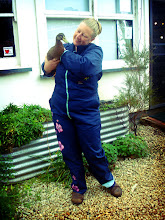The temperate Edible Forest Garden (EFG) movement began in the UK with Robert Hart. Even though some think he
made ‘every mistake in the book’ it still fed him and his brother with leftovers
for locals over many years. A forest garden is such a highly productive system
that even first attempts at the idea created an abundance of food. Robert wrote several books on forest gardening as well as ecology. His best known work is "Forest Gardening".
Patrick
Whitefield built on Hart’s idea and his book “How to make a Forest Garden” was
one of my first permaculture books. It inspired me to turn three plum trees
with grass under them into a forest garden that I ate out of daily.
When I came
across Dave Jacke’s double volumed "Edible Forest Gardens" (with Eric Toensmeier) I was overwhelmed by the sheer amount of information
and dipped in and out of them until I did Dave's course recently at Milkwood
Permaculture. Over many years of design and implementation of edible forest
gardens, with the largest project to date at Wellesley College in Massechusetts,
the tomes have much to share. His course re-introduced me to the appendices at
the back of volume 2 – with many tables on plant use, how they work in forest garden
guilds, and a huge amount of useful information for people growing fruit trees.
Also of use for fruit
tree growers are two ways Dave uses guilds – the ‘resource partitioning guild’
and the ‘mutual support guild’. EFGs are a mimic of a forest. As
permaculturists we recognise that forests have at least three vegetation layers
above the ground. These layers partition the light coming into the system.
Fruit trees are often the overstory in a mixed orchard, but they can be a
middle story growing near to but not under other larger food trees like oaks
and chestnuts, for example in a ‘forest edge’ type pattern.
In EFGs we must
also be aware that a resource partitioning guild also takes the underground
economy into account, with soil moisture and nutrients also being shared with
other plants. When we look at fruit trees in our systems we must look at their
root structure and tolerances as well as their above ground habits. This tells
us the best way to work with the physical structures when choosing the plants
in our EFG and how we work with succession.
When we create guilds
around our heavily cropping fruit trees it is also important to create a mutual
support guild. What plants and animals aid our fruit trees varies with each
species, root stock and cultivar and requires a detailed needs analysis for
each variation. The pear is an example that Dave Jacke uses; European Pears
need calcium, and growing an understory of comfrey that bio-accumulates calcium
is a good pairing for around its roots. This guild with more suitable plants can
be seen above, from the cover of Dave Jacke’s Edible forest garden books. A full size pic is at
Milkwood’s blog: http://milkwood.net/2011/11/18/gardening-like-a-forest-podcast-with-dave-jacke/
In our mutual support
guilds we can also create year round nectar availability for bees and
specialist feeders like hoverflies and give these important pollinators and
predator species habitat and fodder and increase our fruit tree yields. Plants
like yarrow with many functions as a nectarary, dynamic accumulator and living
much plant are excellent additions to forest gardens.
The Wellesley EFG
project can be found here:
This article was originally written for the Permaculture Melbourne Newsletter - "Permaculture Information Exchange" or "PIE". This edition has pages of excellent info on fruit trees - you can join Permaculture Melbourne for access to this amazing resource. There is so much more for me to write on my learning from Dave Jacke - but I do recommend people get the books I've mentioned above and give forest gardening a go. And let me know how you're going or if you need some advice!
I have lots of pics of my forest gardens at http://www.flickr.com/photos/boodicusducky/sets/72157625608069701/
and implementation of the Heritage fruit orchard/forest garden at


No comments:
Post a Comment